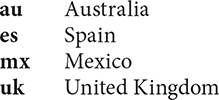Electronic conversation
While face-to-face conversations are still considered to be the best ones, people everywhere are depending more and more on electronic devices for communication. Apart from the fixed telephone, which has been around since 1876—and is still going strong—conversations are now also carried on through cell phones, e-mail, and other electronic devices.
E-mail (electronic mail) enables written conversations that are either typed on a computer or cell phone keyboard or entered on a touch screen on a cell phone or other electronic device. These messages are then sent to the desired recipient via the Internet. In order to use e-mail, you need to have an e-mail address, and you need to know the e-mail address of the person with whom you wish to communicate.
E-mail addresses can be assigned by the company that provides an Internet connection or through companies that issue subscriptions through the Internet. An e-mail address begins with a series of numbers or letters (of the individual’s choosing), followed by the symbol @ (pronounced “at”), and then followed by the name of the provider, a period (pronounced “dot”), and finally a suffix of two or three more letters that indicates the domain—the type of organization that is providing the e-mail account. Here are some examples of these final domain letters:

The suffix can alternatively indicate the name of the source country. For example:

IM
An IM is an “instant message,” designed to get the immediate attention of the person contacted. Electronic devices give an audible signal when an IM is received.
Apps
Apps is an abbreviation for application—the term given to programs that can be used on electronic devices for a variety of purposes—including instant communication.
Texting
Texting is the practice of sending written messages from one cell phone to another, using the receiver’s telephone number.
Texters often leave out the vowels in words or make up abbreviations in order to communicate faster. For example:

Tweeting
Tweeting is the practice of sending written messages to the general public through a commercial website, called twitter.com. Messages are limited to 140 characters. Important or famous people often use this to keep their constituents, clients, or fans informed of what they are doing or thinking.
Emojis
This graphic artwork, usually in digital form, includes a variety of symbols and drawings (including smileys) that can illustrate an IM, email, or text.

Smileys
A smiley is a cartoon—often of a face with an exaggerated expression that is meant to show how the sender of an IM, email, or text feels.

Acronyms
Acronyms are combinations of letters that are used as abbreviations to replace words and expressions. Acronyms and other symbols are commonly used in e-mail, texting, and tweeting. They may be in all capital (uppercase) letters, all lowercase letters, or a combination of the two. There are really no rules!
Following is a list of commonly used acronyms and other symbols:



“Translate” each of the following messages.
1. Cn U cm ovr asap?
________________________________________________________________
2. AYS? im @schl. BBB
________________________________________________________________
3. its OVR btwn us. sory
________________________________________________________________
4. lol UR crzy
________________________________________________________________
5. im :( w/o U
________________________________________________________________
6. me2
________________________________________________________________
7. CU L8r
________________________________________________________________
8. OMG shes OTL
________________________________________________________________
Write a text message conversation between you and a good friend. Use at least ten acronyms, symbols, or other abbreviations. Ask an English-speaking friend to check your work.
________________________________________________________________
________________________________________________________________
________________________________________________________________
________________________________________________________________
________________________________________________________________
________________________________________________________________
________________________________________________________________
________________________________________________________________
________________________________________________________________
________________________________________________________________


